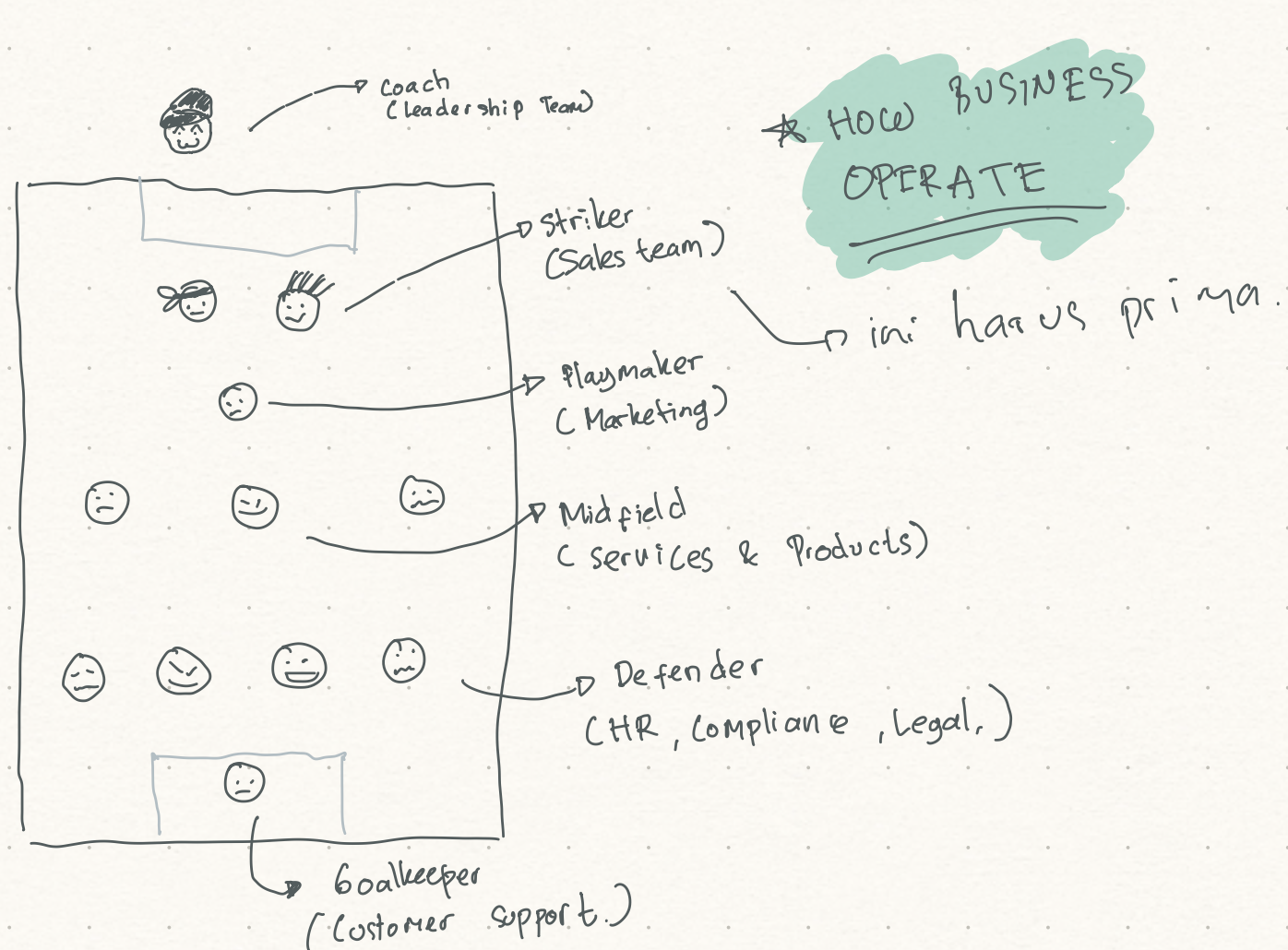
Sales Essentials for Directors
Outcome: Fokus ke input yang bisa kamu kontrol, pilih input yang benar‑benar terhubung ke output, tampil rapi‑premium‑bersih, dan jaga keautentikan untuk bangun trust jangka panjang.
Bayangin kamu tukang bakso yang enaknya nggak ketulungan. Kuahnya gurih, dagingnya juicy, ada menu iga sedap, yang nyobain langsung pengen adopt kamu si Tukang Bakso. Tapi… the thing is, kamu jualannya di tengah hutan. Hutan Alas Purwo lagi. Orang takut beli, bang. To make it worse, kamu jualan service—sesuatu yang intangible, nggak bisa dipegang, persis demit.
Nothing more sad than seeing product/service keren, tim solid, tapi sales pipeline macet. Product/awesome service itu baru setengah kerjaan. Saya belajar dengan cukup mahal bahwa ini justru jadi hal kedua terpenting untuk bangun bisnis yang benar—profitable business. Jago bikin product bukan jaminan sukses. Bakso itu harus dipasarkan dengan ciamik.
Di sini saya sharing pengalaman dari 2–3 tahun terakhir fokus manage Sales & Marketing, terutama untuk Indonesia market. Daftar ini lahir dari dosa dan kesalahan, bukan best practice lengkap (di bawah saya cantumkan beberapa buku yang worth dibaca).
Hopefully you can steal one or two things from the list. 😉
Worry About Input, Not Output
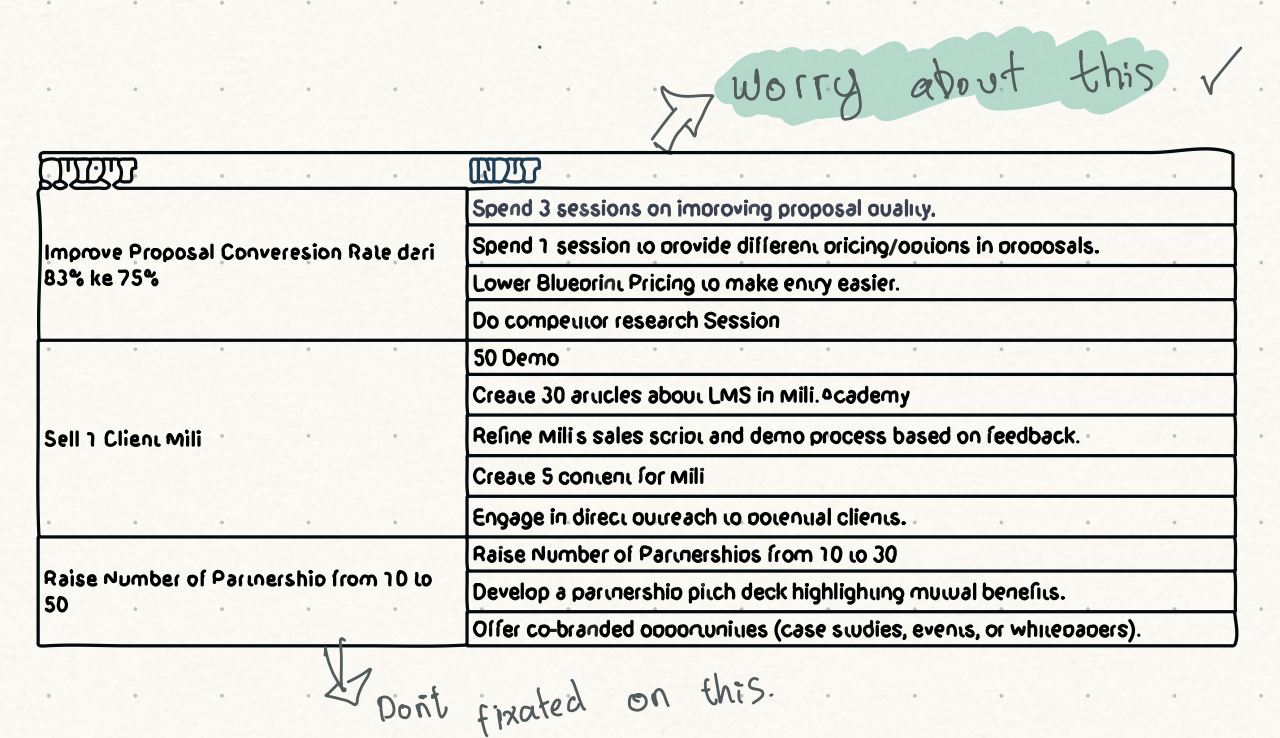
–Spend 3 sessions on improving proposal quality? Mungkin tambah satu sesi lagi buat improving spelling dulu, ya.
Di marketing dan sales, ada dua hal penting: input dan output.
- Output: hasil yang kamu mau—closing client, conversion naik, partnership nambah.
- Input: effort yang kamu lakukan—jumlah demo, artikel, outreach, meeting.
Kebanyakan tim sales cuma fokus ke output. Setiap bulan laporan angka—total leads, revenue, conversion rate—tapi jarang bahas input. Masalahnya: output nggak 100% di kontrol kamu.
Contoh: target kamu closing 2 client bulan ini. Kamu udah effort, tapi Januari awal semua client delay keputusan karena para bos liburan. You can influence output, but you can’t directly change it.
Sementara input 100% di kontrol kamu. Kamu bisa atur berapa meeting, email, dan demo. Jadi, worry about input. Set input goals, track progress, dan diskusikan input setiap minggu dengan tim. Kalau ada yang tanya, “Minggu lalu berapa meeting sama client?” atau “Berapa artikel yang kamu publish?”, jawab luar kepala.
Make Sure Input Will Bring You Output
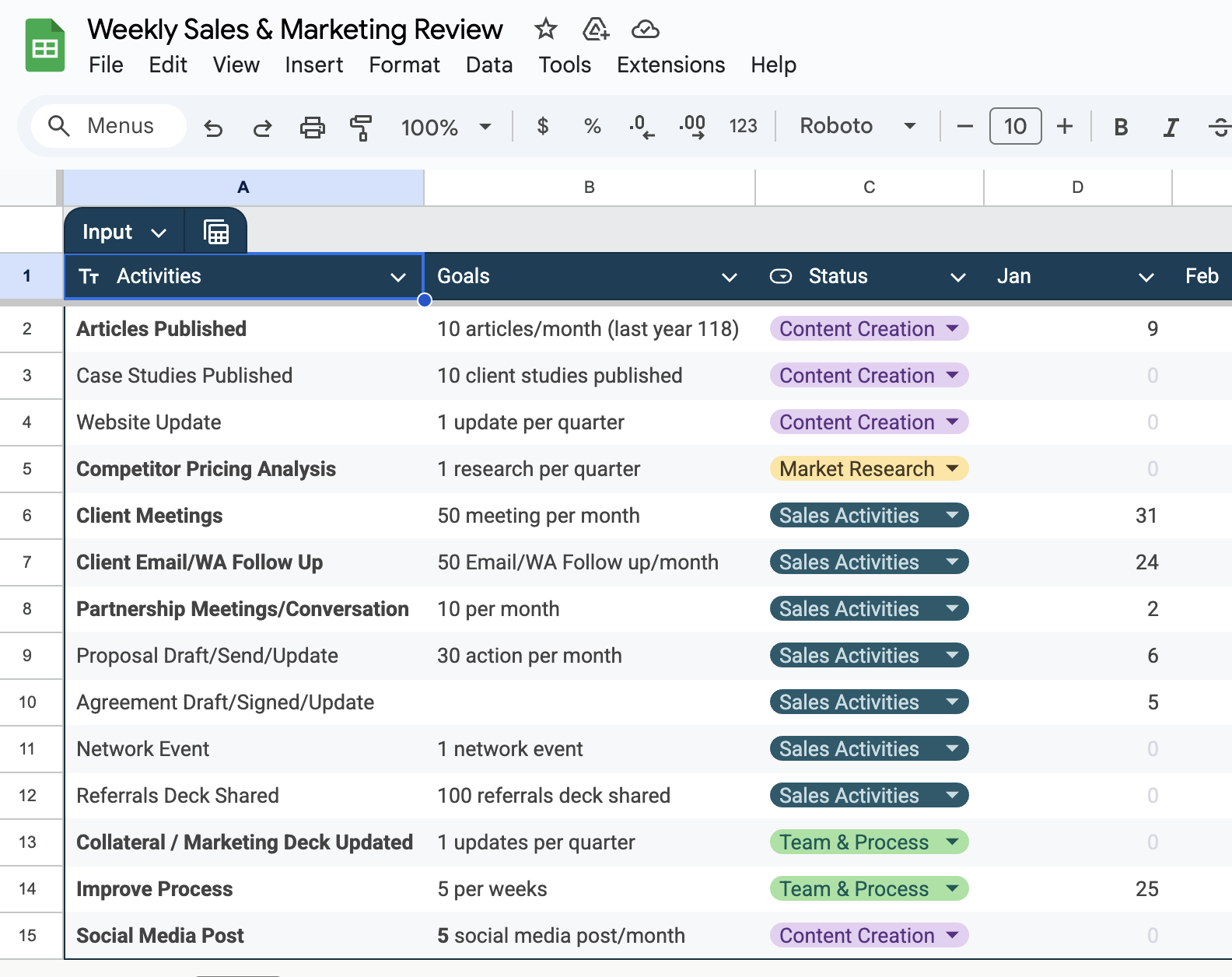
Salah satu hal tersulit adalah “mendekatkan” input ke output. Idealnya, input yang kamu lakukan linear menuju output. Kalau 30 artikel → 300 visitor, maka 300 artikel → 3.000 visitor. Itu contoh input yang nyambung ke output.
Problemnya, sering kali input yang kita kira impactful ternyata nggak nyambung.
- 🔴 Jumlah artikel belum tentu berbanding lurus dengan jumlah visitor.
- 🔴 Jumlah cold call belum tentu berbanding lurus dengan conversion.
- 🔴 Jumlah demo belum tentu berbanding lurus dengan closing deal.
Kalau salah pilih input, kamu cuma efisien di hal yang salah. Peter Drucker: “There is nothing so useless as doing efficiently that which should not be done at all.” Tugas kamu: bukan cuma produktif di input, tapi pastikan input itu benar‑benar impactful ke output.
Ada beberapa hal yang bisa kamu lakukan biar nggak buang waktu di strategi yang nggak work.
- Jangan selalu mengandalkan insting. Banyak yang eksekusi berdasar feeling. “Banyak artikel = banyak leads!” atau “Spam LinkedIn = banyak yang tertarik!”. Bisa benar, bisa salah. Capture data dari pipeline ke sales. Tanpa tracking, kamu jalan di kegelapan tanpa senter.
- Jadwalkan review proses. Sibuk ≠ produktif. Banyak yang stuck di rutinitas tanpa impact karena nggak pernah review progress. Set waktu mingguan/bulanan untuk audit input: kalau 1 bulan nggak ada impact ke angka bisnis, tweak strategi atau stop.
- Stop doing what doesn’t work. Jangan maksa strategi gagal. Kalau artikel nggak ada yang baca, bikin 10x lipat bukan solusi.
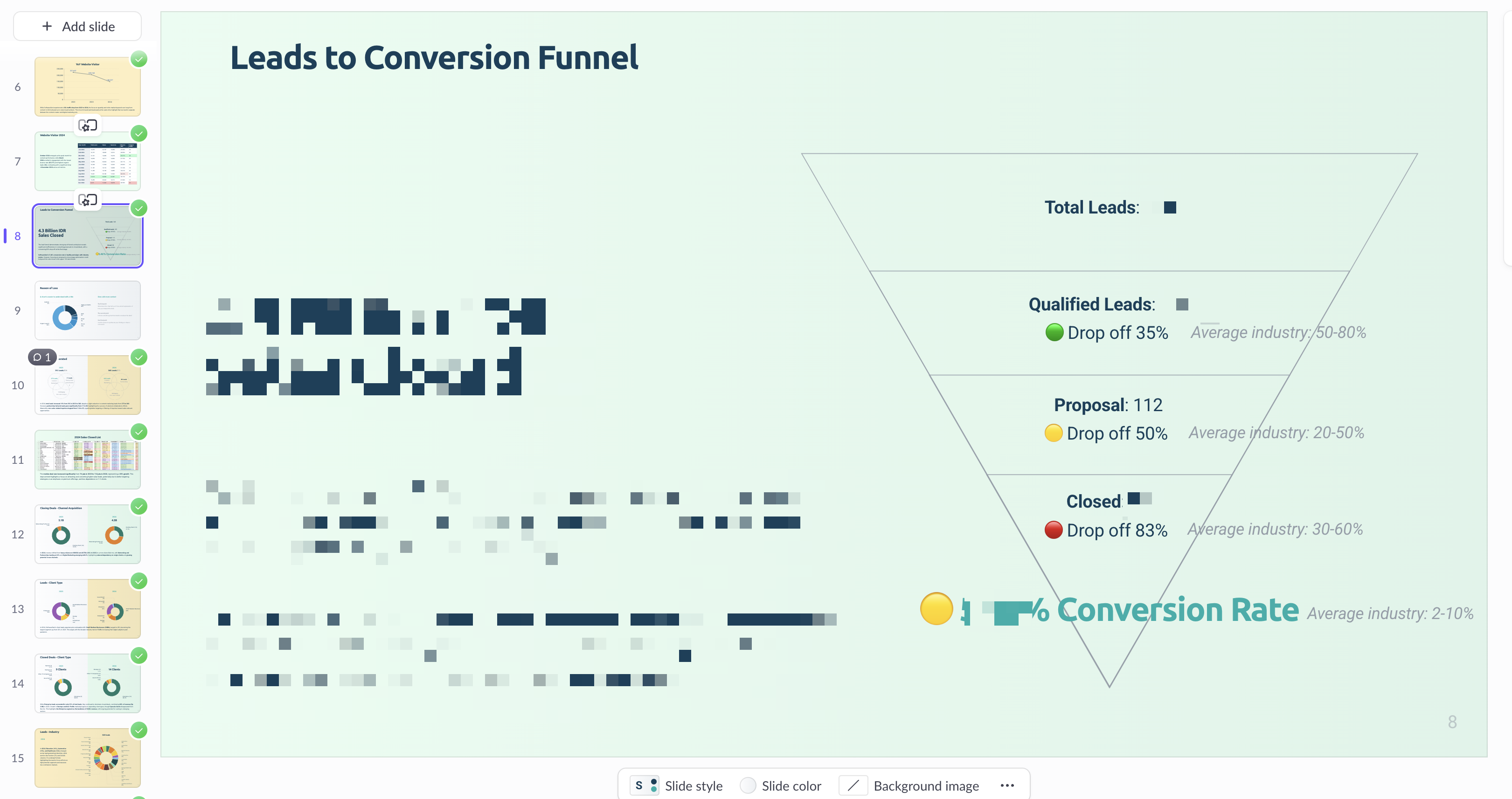
Analysis funnel dan compare data leads vs sales bantu kamu tahu mana input yang relevan dan mana yang nggak.
Kelihatan Rapi, Premium Dan Bersih

–Bro kiri: ‘Kerja buat hidup.’ Bro kanan: ‘Hidup buat kerja.’
Buat yang nanya apakah sales itu boleh tampil apa adanya, jawabannya: nggak bisa. Sayangnya, penampilan kamu nggak bisa apa adanya. Saya juga pengen bilang klien nggak bakal nilai dari tampang, tapi kenyataannya first impression itu nyata.
Kalau kamu kelihatan gak representative, klien bakal ragu. Apalagi kalau jualan kamu high-ticket atau kliennya level enterprise.
On the other hand, terlalu fancy juga bisa backfire. Bayangin kamu dateng pake Mercy, tas LV, jam Rolex, sementara kliennya masih cicil mobil. Bisa-bisa mereka mikir, “Orang ini nge-charge gue terlalu mahal gak ya?”
Jadi, penampilan harus rapi, premium, tapi tetap approachable. Nggak perlu pake merek luxury (apalagi palsu). Yang penting jangan bikin client mikir, “oh, yah, kayaknya biasa aja ya Mas/Mbaknya.” Beberapa tips:
- Baju–Uniqlo diskonan (red label, baby!). Nggak murah banget, tapi juga nggak norak. Aman buat segala situasi.
- Sepatu–Sepatu bersih itu harga mati. Mau semahal apapun, kalau kotor ya tetep kelihatan kumel. Clean > fancy. Bersihin di awal minggu kalau mau ketemu client.
- Jam tangan–Pake jam. Bukan buat gaya, tapi buat kasih sinyal kalau kamu professional. Nggak perlu Rolex, atau Apple Watch Ultra, yang penting fungsional dan classy.
- Tas–Premium, bukan luxury. Cara bedain gampang: kalau yang dijual cuma harga, skip. Saya udah pake Filson bag hampir 9 tahun, masih awet. Durable bags = sinyal kamu paham quality over hype.
Golden rule-nya? Rapi, premium (bukan luxury), dan yang paling penting: bersih. 🚀
Authentic
Lupa siapa yang bilang, tapi mata uang utama bisnis adalah trust. Kalau calon client ngerasa kamu authentic, itu bantu bangun long‑term trust. Cara termudah untuk autentik adalah hindari bullshit. Kebanyakan decision maker sudah kenyang pengalaman dan peka—mereka bisa endus bullshit dari jauh. Kadang mereka mentolerir kalau value‑mu menarik. But all things equal, mereka cenderung pilih orang yang mereka percaya.
Be transparent soal strength, dan jelaskan upfront limitasi produk/jasa—bahkan sebelum ditanya. Share struggle dan ceritakan bagaimana kamu menyelesaikannya.
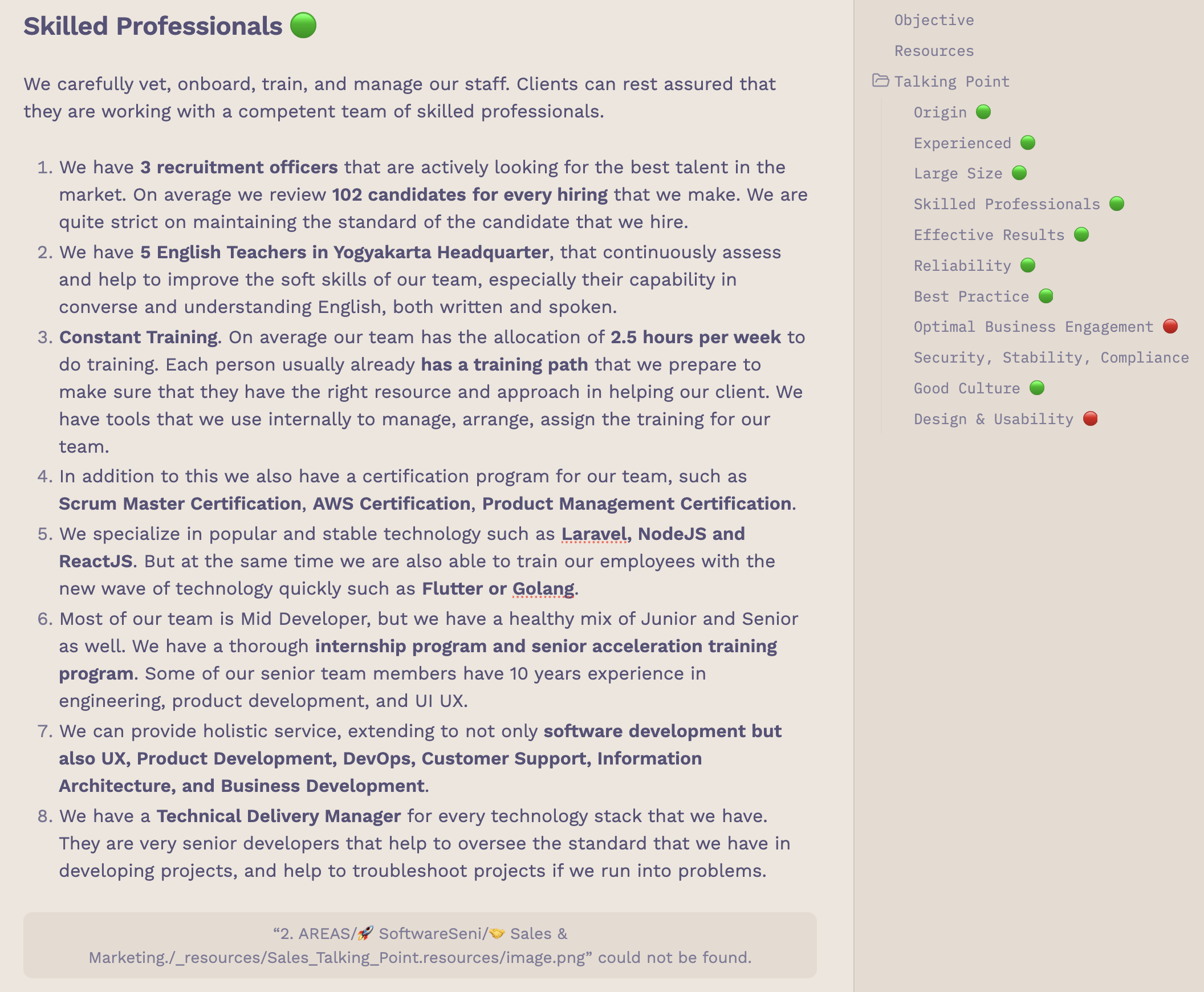
Yes, ini contoh contekan. Selalu siapkan talking points. Ditato di tangan lebih oke lagi.
Next Steps
- Tetapkan 3–5 metrik input yang kamu kontrol (mis. meeting/minggu, demo/minggu, outreach/hari, artikel/bulan). Tulis targetnya.
- Buat ritual review mingguan: audit input vs output. Jika tidak ada dampak → perbaiki atau hentikan.
- Validasi keterhubungan input → output dengan data sederhana (spreadsheet/CRM). Simpel aja: jumlah input, output, rasio.
- Rapikan penampilan: ceklis baju, sepatu, jam, tas. Bersih > fancy.
- Siapkan 1 halaman talking points per client: masalah mereka, value prop kamu, batasan yang perlu diketahui, next step.
- Buat report funnel bulanan (lead → meeting → proposal → deal) untuk melihat bottleneck dan input mana yang paling berdampak.
Next: Network beats everything else, by a large margin.
Network Beats Everything Else
Network = unfair advantage tercepat. Prospek hangat mengalahkan cold outreach 9 dari 10 kali.
- Peta ekosistem: pembeli, influencer, partner, alumni, komunitas, media niche.
- Give sebelum ask: perkenalan, catatan playbook, template dokumen, feedback gratis 30 menit.
- Bangun “watering holes”: small dinners, WA/Telegram group, mini‑webinar per 6 minggu.
- Muncul offline: konferensi/meetup relevan; target 3 percakapan berkualitas per event.
- Champion strategy: temukan 1 orang di tiap akun yang mau “jualan” untukmu; bekali talking points + deck 5 slide.
- CRM‑kan jaringanmu: tag per industri, kekuatan hubungan (1–5), dan last‑touch.
- Main long game: 6–18 bulan itu normal. Konsisten, ringan, tidak needy.
Contoh minta referal (singkat):
“Mas/Bu [Nama], kalau ada rekan yang lagi [masalah spesifik], boleh kenalin saya? Dua kalimat saja ke WA mereka sudah cukup. Saya kirim contoh template perkenalannya.”
Qualification: Jual ke Orang yang Tepat
Jangan jual ke semua orang. Kualifikasi cepat selamatkan waktu, uang, dan stamina.
Tanyakan 5 hal ini di 15 menit pertama:
- Masalah: “Apa yang lagi bikin pusing sekarang?”
- Urgensi: “Apa yang terjadi jika ini tidak selesai 90 hari?”
- Dampak/anggaran: “Nilai bisnisnya kira‑kira di kisaran berapa?”
- Proses keputusan: “Siapa saja yang harus oke sebelum jalan?”
- Timeline: “Kapan idealnya mulai dan go‑live?”
- Green lights: masalah nyata, urgensi waktu, sponsor internal jelas, akses pengambil keputusan.
- Red flags: “cuma lihat‑lihat”, “nanti saya kabari”, tidak ada timeline/anggaran, banyak “mungkin”.
Pricing That Signals Value
Harga = sinyal kompetensi. Murah bukan strategi, jelas dan bernilai adalah strategi.
- 3 opsi (Good/Better/Best): jangkar persepsi nilai; biarkan klien memilih tanpa menawar.
- Value > jam kerja: kaitkan harga ke outcome (penghematan, peningkatan revenue, risk reduction).
- Payment terms: contoh 50/30/20 atau 40/40/20; milestone jelas.
- Diskon sehat: time‑bound, tukar dengan scope, testimoni, atau pembayaran dimuka—bukan gratisan.
- Pilot/Discovery berbayar: kecil, 2–4 minggu, kriteria sukses jelas, jalan ke fase penuh.
Proposal yang Menang
Proposal = cerita singkat yang membuat “ya” itu mudah.
Struktur 1–pager + lampiran jika perlu:
- Ringkasan eksekutif: 4–6 kalimat masalah → pendekatan → nilai.
- Opsi & investasi: 3 paket, apa yang masuk/keluar scope.
- Timeline & rencana kerja: fase, deliverable, peran tim klien.
- Asumsi & risiko: tulis eksplisit; tampilkan kamu berpikir matang.
- Bukti: case singkat, metrik, referensi.
- Next step: “Jadwalkan kick‑off, tanda tangan, invoice #1”.
Anti‑ghosting: selalu kirim versi link + PDF, dan jadwalkan call pembahasan saat mengirim.
Follow‑Ups yang Menjaga Momentum
Setiap interaksi ditutup dengan next step kalender.
- Tutup meeting dengan booking berikutnya (15–30 menit) di tempat.
- Email ringkasan di hari yang sama: keputusan, risiko, tugas, tanggal.
- Ritme follow‑up: T+2, T+5, T+7; lalu break‑up email sopan berisi opsi.
- Template singkat: “Ringkas: 3 poin; Keputusan: X; Next: call 20 menit Kamis?”
Pipeline Hygiene & Forecast
Pipeline bersih menang dari pitch bagus.
- Definisikan tahap dan exit‑criteria: Lead → Discovery → Proposal → Negosiasi → Closed.
- Probabilitas per tahap realistis; forecast = sum(value × prob).
- Coverage: 3–5× target bulanan/kuartalan di top‑of‑funnel.
- Bersih‑bersih mingguan: zombie deals keluar, duplikat merge, catatan rapi.
Proof: Case Study & Referensi
Bukti sosial menutup jarak kepercayaan.
- Template case: konteks → masalah → pendekatan → hasil (angka) → kutipan.
- Minta izin kutip nama/logo atau pakai “perusahaan F500 di industri X”.
- Siapkan 2–3 klien yang bersedia jadi referensi telepon 10 menit.
Tooling Minimalis (Gunakan yang Ada)
- CRM: yang tim mau pakai tiap hari (boleh mulai spreadsheet → naik kelas nanti).
- Dokumen: satu repo rapi untuk proposal/templates (Drive/Notion dsb.).
- E‑signature & invoicing: sederhana, bisa dilacak, template konsisten.
- Scheduling: link untuk memotong back‑and‑forth.
Bacaan yang Worth It
- SPIN Selling — pertanyaan yang mendorong kebutuhan nyata.
- The Challenger Sale — mengajar, menyesuaikan, mengontrol momentum.
- Obviously Awesome — positioning yang bikin kamu mudah dipahami.
- Never Split the Difference — negosiasi praktis untuk deal.
- Influence — psikologi pengaruh (gunakan etis).
Penutup
Clarity over polish. Speed over perfect. Feedback over assumption.
- Fokus input yang bisa kamu kontrol.
- Pilih input yang benar‑benar terhubung ke output.
- Tampil rapi‑premium‑bersih; jaga autentik.
- Bangun network; kualifikasi cepat; proposal ringkas; follow‑up disiplin.
Let’s go. Next step: audit pipeline kamu minggu ini dan pilih 3 input yang akan kamu gas 30 hari ke depan.
